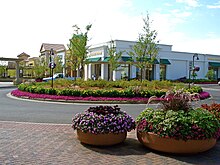Lifestyle center
This article needs to be updated. (March 2015) |


A lifestyle center (American English), or lifestyle centre (Commonwealth English), is an open-air shopping center which aims to create a "pedestrian-friendly, town-like atmosphere with sidewalks, landscaping, ambient lighting, and park benches.[1] Memphis developers Poag and McEwen are generally credited with developing the concept in the late 1980s.[1] Lifestyle centers emerged as a major retailing trend in the late 1990s. Sometimes labeled boutique malls or ersatz downtown, they are often located in affluent suburban areas.
History
[edit]The proliferation of lifestyle centers in the United States accelerated in the early 21st century, growing from 30 nationally in 2002 to 120 at the end of 2004.[2] They lie on the upscale end of commercial development, with discount-based outlet malls on the low end.
Design
[edit]Lifestyle centers typically require less land and may generate higher revenue margins, generating close to $500 per square foot, compared to an average of $330 per square foot for a traditional mall, according to the president of Poag and McEwen.[2] Other advantages lifestyle centers have over traditional enclosed malls are savings on heating and cooling and quicker access for customers.[1]
Unlike the traditional commercial layout of strip shopping centers, lifestyle centers present their formal storefronts as facing each other across a landscaped pedestrian walkway or a low volume two-lane road. Those with a more extensive street grid or more multifunctional and dense development include offices, hotels, residential, retail, and entertainment, often with a designated function to act as the community's center.[3] One of the earliest proponents of lifestyle centers was RED Development, which built centers primarily in the Midwest and Southwest United States.[3]
See also
[edit]References
[edit]- ^ a b c Donnellan, John (2014). Merchandise Buying and Management (4th ed.). New York: Fairchild Books. p. 63. ISBN 9781609014902. Retrieved February 27, 2023.
- ^ a b Bhatnagar, Parija (2005-01-11). "CNN article: "Not a mall, it's a lifestyle center"". Retrieved 2006-05-26.
- ^ a b Lipp, Linda (February 18, 2004). "Fort Wayne, Ind., Pioneered 'Lifestyle' Shopping Center Trend in U.S." Ft. Wayne News-Sentinel. Retrieved 12 November 2018.
External links
[edit]- "List of lifestyle centers", USA Today, January 31, 2007
